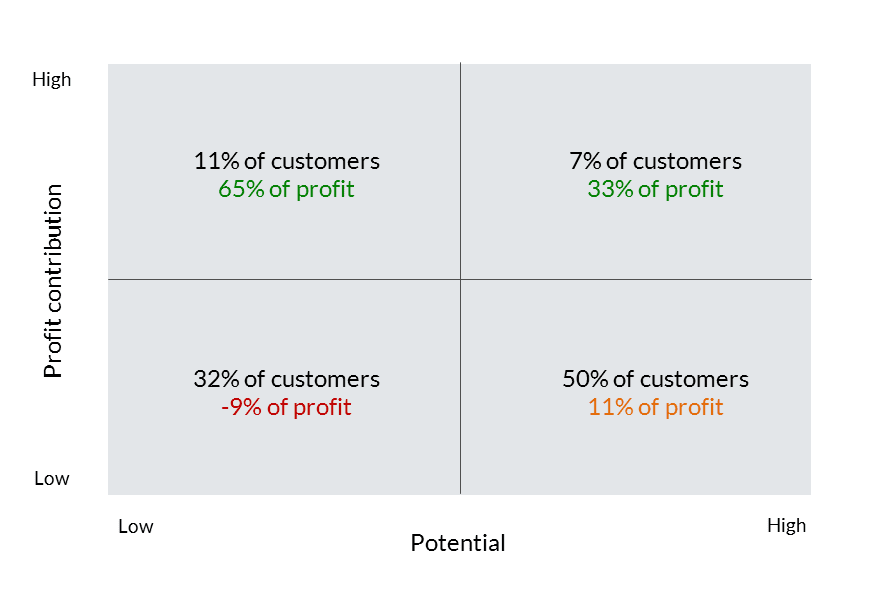Although recessions are generally bad for business, research shows that some companies not only survive the crisis but come through it thriving, increasing annual sales by 9% and profitability (EBIT) by 3 pct. points, while in general, companies see a sales decrease by 2%. Recession preparation was found to be the key, but only a handful of companies (11%) were found to be in that category. Those companies pulled ahead of competition.
Whether a company falls in the winning or losing category will to a large extend depend on sales and marketing leaderships’ ability to take action before, during and after the economic downturn.
1. How will we adjust our go-to-market approach to a new market reality?
2. How will we adjust our organisation and sales/marketing spend?
3. What will we do when recession hits and when the market bounces back?
In reality, recessions are both a threat and opportunity at the same time. A threat to the unprepared and an opportunity for those set up take advantage of the new situation.
Leadership preparation and action is the difference between recession as a crisis or golden opportunity to pull ahead of competition.
You can’t cut what you don’t understand
Marketing budgets are typically amongst the first places to trim, due to the relative ease of adjusting spend. To be successful, commercial leaders need to know upfront exactly where and what to cut.
To avoid the risk of cutting marketing activities that have a high impact on performance, the marketing leader needs a clear overview of how marketing investments are split on e.g. search marketing, organic SoMe, content marketing etc. and how each of these investments are performing.
Many marketing organisations apply the 70-20-10 rule, where 70% of budget goes to core marketing activities where the results are known and can be fairly accurately forecasted, 20% goes to new experiments where pay-off is expected and 10% bets on the future with pay-off unknown.
During recessions when budgets are cut to the core, so is marketing spend. The marketing leader needs to understand which activities are part of the core, so budgets can be adjusted with minimum impact on performance.
Exhibit 1
Take Action
Categorise marketing activities & investments into Core, Experimental and Future based on risk and performance, so budgets can be adjusted with a minimum of performance impact

Double down on your most important people and customers
Sales leadership of companies that win after downturns prepare by having a detailed understanding of customer value and the performance and potential of different available sales channels. Knowing in advance exactly where to direct scarce resources and where to cut is key.
The only real lever to cut spending in a sales organisation is by adjusting capacity costs. That is tricky because it requires adjusting the size of the salesforce and thus very likely will impact revenue negatively. To add to that, studies show, that those who are able to invest heavily in new market plays just as a recession is over pulls severely ahead of competition.
Hitting the gas on new market plays is difficult to do if the salesforce has been severely amputated during the recession and companies run the risk of not being able to take advantage of the market uptake quickly, once the recession is over.
When cutting salesforce cost because of recession you want to minimize the negative impact on revenue and reduce the risk of missing the beat once the recession is over. The key to do so is by understanding the value and the potential of different customer categories and the cost and performance of existing and potential sales channels – both physical and digital.
Being proactive about understanding customer value and sales channels deeply makes Sales Leaders able to play around with potential impact on revenue and cost in different sales channel configurations. It could be choosing the less costly inside sales channel to low value, low potential customers, creating online alternatives for more transactional type interactions or laying off salespeople that does not contribute enough to the top-line.
Sales leaders that are proactively considering how to act when a downturn hits have a foundation for strong decision making. They will know precisely which customers matter the most to performance and the pros and cons of different sales channels configurations so that intelligent changes can be made quickly with as much impact on cost and with as little damage to revenue as possible.
Exhibit 2
Take Action
Segment your customer portfolio so you understand which accounts to focus sales resources towards when you are forced to cut cost. For example, get ready to move lower value customers to be serviced by the less costly inside sales function and quietly assess your salesforce so you know which salespeople are really impacting top-line.

Prepare the downturn battle plan in the commercial leadership team
Commercial leadership teams of winning companies are fully aligned and prepared on the course of action when the downturn hits, to avoid it turning into a company crisis.
The ability to make the right decisions fast is key to adjust the sales and marketing organisation to a new business reality without putting current or future business at risk. This comes down to preparation and alignment across the sales and marketing leadership team on what to do, before the situation is there requiring instant action. Winning teams know that a recession won last for ever and has plans and market plays in place for when things again are starting to look bright.
Preparing for a downturn while things are going great is challenging for organisations, but crucial for leadership.
Take action: Conduct a series of workshops led by the CCO, CEO or external, where best-case, base-case and worst-case recession scenarios are mapped out and associated company course of actions are created. Agree beforehand on leadership team roles, responsibilities and management cadence for the first 3 months of the recession.









